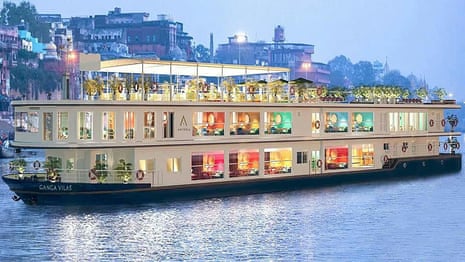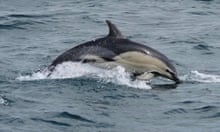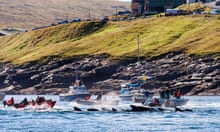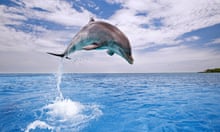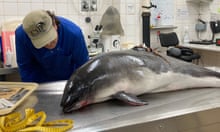The Indian prime minister, Narendra Modi, has officially launched the “world’s longest river cruise” from the city of Varanasi in Uttar Pradesh. The luxury voyage will last 51 days, travelling 3,200km via Dhaka in Bangladesh to Dibrugarh in Assam, crossing 27 river systems.
The three-deck MV Ganga Vilas, with 18 suites, is the latest venture in a trend for cruise tourism in India being promoted by the government. Modi hailed the cruise industry on the Ganges as a “landmark moment”, which will herald a new age of tourism in India.
However, environmentalists and conservationists say the rise in cruises could do lasting damage to the habitat of the Ganges river dolphin (Platanista gangetica).
The MV Ganga Vilas will pass through Kaithi village, 30km from Varanasi at the confluence of the Ganges and Gomti River, where the deep water and slower currents around the intersection provide a safe habitat for the endangered dolphin. In October, wildlife officials spotted a pod with calves, and put the number of dolphins in the area at 35 to 39.
It is one of a number of protected cetacean habitats on the route of the cruise, including Vikramshila Gangetic Dolphin Sanctuary in Bihar.
Platanista gangetica is one of the two freshwater dolphin species in south Asia, alongside Platanista minor or the Indus river dolphin, found in Pakistan and the Beas River in north India. The Ganges river dolphin faces a number of threats, including water pollution, excessive water extraction and poaching.
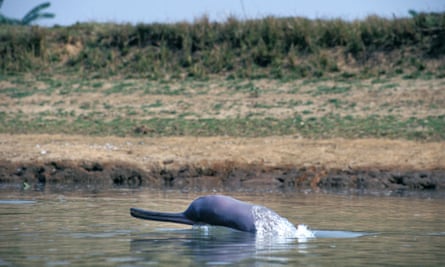
“The cruises are a dangerous proposition in addition to all the existing risks for the dolphins,” said Ravindra Kumar Sinha, whose conservation efforts led the government to designate Gangetic dolphins as a protected species in the 1990s. Their numbers have risen in recent years, with about 3,200 in the Ganges and 500 in the Brahmaputra, due to improved water conditions and conservation initiatives. But Sinha fears cruise tourism will undo these gains. He believes Gangetic dolphins may follow the fate of Baiji dolphins in China, which were declared functionally extinct in 2006 due to increased river traffic on the Yangtze. “There’s no doubt that disturbances from cruises will gravely impact the dolphins, which are sensitive to noise,” he said.
Gangetic dolphins are “almost blind” and navigate the murky waters and forage for food using echolocation clicks. Jagdish Krishnaswamy, an ecohydrologist from the Indian Institute for Human Settlements in Bangalore, said: “The underwater noise pollution due to the increased traffic of cruise, cargo vessels and mechanised boats interferes with the echolocation clicks making their very existence arduous.”
A 2019 study by Krishnaswamy and three other experts, using cetacean and porpoise detection devices to log the echolocation clicks, found major alterations to the acoustic responses of Gangetic dolphins from high underwater noise due to motorised vessels. Chronic noise exposure elevated stress levels leading to fatigue, and changed foraging behaviour, causing them to feed more to compensate for energy loss. Disorientation from prolonged response to underwater noise also increased the risk of clashing with vessels and getting entangled with propeller blades, leading to injury or death.
Cruises between Varanasi and Kolkata began in 2009. But a World Bank-funded project to develop inland waterways, called the Jal Marg Vikas Project or National Waterway-1 (NW-1) on the Ganges, is being used by the Bharatiya Janata party government to boost tourism and promote cargo movement in an “eco-friendly way”.
after newsletter promotion
Kashif Siddiqui, marketing director of Antara cruises, said the MV Ganga Vilas cruise was so popular that trips were sold out for the next two years. “We are following all the environmental precautions and government guidelines,” he said. Promotional material for the cruise, says: “With sustainable principles at its heart, the Ganga Vilas incorporates pollution prevention and noise control technologies to honour the ancient rivers travelled through.”
At present, about 100 cruise trips operate on the NW-1 Ganges and NW-2 Brahmaputra routes, with the government looking to increase the number 10-fold. Development on this scale, environmentalists say, would have huge adverse effects on the riverine ecosystem. In 2019, a turtle wildlife sanctuary spanning a 7km protected area in the Ganges at Varanasi, was denotified, in what critics said was a move to open up the area to development of the waterway.
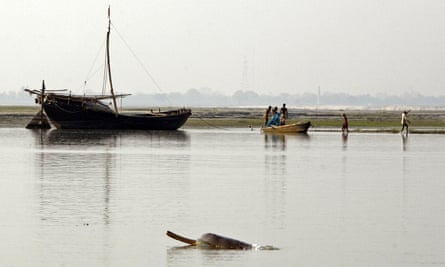
There are also fears over high vibrations and noise from dredging operations to maintain minimum depths for navigation of cruise vessels on the NW-1 Ganges route.
An environmental assessment carried out by the Inland Waterways Authority of India said that behavioural changes in fish, dolphins and turtles due to dredging noise “may not be significant” and mortality is not anticipated, because these organisms “normally move away from the dredging spots”.
However, Sunil Kumar Chaudhary, a member of Bihar State Ganga rejuvenation, protection and management committee, said: “Unlike the ocean, river landscape is restricted, and dolphins do not have a vast area to manoeuvre at the time of dredging activity.”
Avli Verma, a researcher at Manthan Adhyayan Kendra centre in Pune, which studies water and energy policies, said the government had set aside necessary environmental safeguards in favour of an “ease of doing business” approach.
“If precautionary conservation principles are not applied today, waterways will not be sustainable in the long term. You cannot promote cruises on Ganga as eco-tourism, while endangering the habitat and the existence of Gangetic dolphins.”
This article was amended on 19 January 2023 to clarify that there are about 100 cruise trips a year on the NW-1 Ganges and NW-2 Brahmaputra routes, rather than about 100 cruise companies operating on the routes as an earlier version could have suggested.
Find more age of extinction coverage here, and follow biodiversity reporters Phoebe Weston and Patrick Greenfield on Twitter for all the latest news and features
